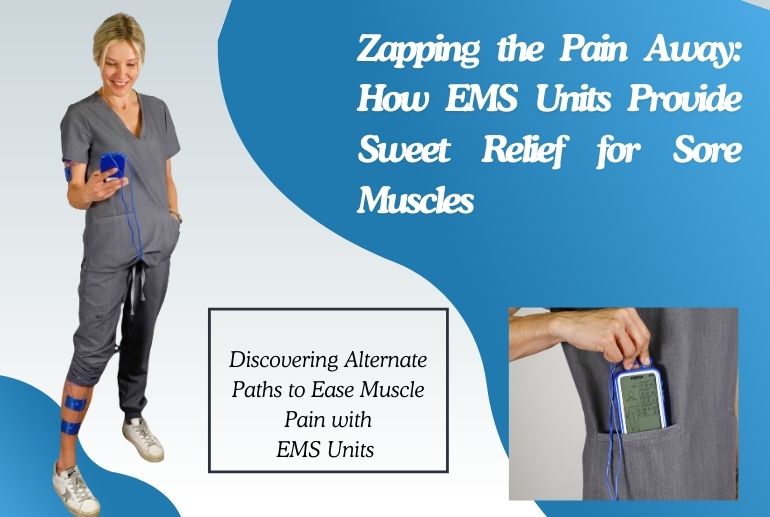Zapping the Pain Away: How EMS Units Provide Sweet Relief for Sore Muscles

Posted by Elizabeth Carroll
"Bought this kit a couple of years ago for my daughter and it has helped a lot with tight muscles or muscular spasms. She moved and took her precious unit with her. So I finally get one of my own. So happy!"

Ever heard of those little devices that make your muscles twitch and contract, almost as if they're doing a mini-workout on their own? That's an EMS unit, also known as an electrical muscle stimulation machine. And while they might seem a little strange at first, they're actually a fantastic tool for managing muscle pain. Let's dive into how they work, the types of pain they can help with, and why you might want to consider adding one to your home.
What is an EMS unit and how does it work?
In a nutshell, an EMS unit is a device that sends mild electrical impulses to your muscles, causing them to contract and relax. It’s like a tiny personal trainer, giving your muscles a gentle workout without you having to lift a finger.
Here's a quick breakdown of how it works:
-
You attach sticky electrode pads to your skin over the area where you're experiencing pain.
-
The EMS unit sends electrical signals through the pads to your muscles.
-
These signals mimic the natural signals your brain sends to make your muscles move.
-
Your muscles contract and relax in response to the signals, increasing blood flow and helping to reduce pain.
It's like giving your muscles a mini-massage from the inside out!
EMS units for muscle pain relief can be a real lifesaver when it comes to managing muscle pain. They work in a few different ways to provide relief:
-
Increased blood flow: The contractions caused by the EMS unit help to improve blood circulation in the targeted area. This increased blood flow brings more oxygen and nutrients to your muscles, which can help to reduce inflammation and promote healing.
-
Endorphin release: Just like exercise, EMS can stimulate the release of endorphins, your body's natural painkillers. These endorphins can help to block pain signals and create a sense of well-being.
-
Muscle relaxation: The gentle contractions and relaxations can help to loosen tight muscles and reduce muscle spasms, which are often a major source of pain.

Now that we know how EMS units work their magic, let's explore some of the common types of muscle pain they can help with:
-
Delayed Onset Muscle Soreness (DOMS) : That achy feeling you get a day or two after a workout? That’s DOMS, and it’s caused by tiny tears in your muscle fibers. EMS can help to reduce the severity and duration of DOMS by increasing blood flow and promoting muscle repair.
-
Chronic Pain: If you suffer from chronic pain conditions like fibromyalgia or arthritis, EMS can be a helpful tool for managing your symptoms. The endorphin release and muscle relaxation can provide much-needed relief.
-
Back Pain: Back pain is incredibly common, and it can be caused by a variety of factors, including muscle strain, poor posture, and herniated discs. EMS can help to relax tight muscles in your back and improve blood flow, which can reduce pain and stiffness.
-
Neck Pain: Whether it's from hunching over a computer all day or sleeping in an awkward position, neck pain can be a real pain in the neck (pun intended!). EMS can help to loosen those tight neck muscles and improve your range of motion.
Post-Injury Pain: If you've recently experienced an injury, such as a sprained ankle or pulled muscle, EMS can be a helpful part of your rehabilitation process. It can help to reduce pain and swelling, improve muscle strength, and prevent muscle atrophy.
EMS units offer a safe and effective way to manage muscle pain from the comfort of your own home. Whether you're dealing with DOMS, chronic pain, or recovering from an injury, EMS can help to reduce pain, improve muscle function, and get you back to doing the things you love.
So, if you’re looking for a drug-free way to soothe your aching muscles, an EMS unit might just be the answer. Just remember to consult with your doctor before starting any new treatment, and always follow the instructions carefully.
With a little buzz, you can say goodbye to muscle pain and hello to a more comfortable, active life.
Are EMS units safe to use at home?
Yes, EMS units are generally safe to use at home when used as directed. However, it's always a good idea to consult with your doctor before using an EMS unit, especially if you have any underlying health conditions.
How often should I use an EMS unit?
The frequency of use will depend on your individual needs and the specific type of pain you're experiencing. It's best to start with shorter sessions and gradually increase the duration as your muscles get used to the stimulation.
Can EMS units help me build muscle?
While EMS can help to strengthen muscles, it's not a substitute for regular exercise. It's best to think of EMS as a complementary tool to your fitness routine.
Are there any side effects of using an EMS unit?
Some people may experience mild skin irritation or muscle soreness after using an EMS unit. If you experience any discomfort, stop using the device and consult with your doctor.
SHARE:

